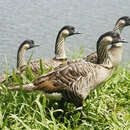Biology
(
الإنجليزية
)
المقدمة من Arkive
Nene have the longest nesting season of any wild goose species; eggs are laid in the winter months from August to April, although most eggs are laid during November-January (2). Females lay eggs in hollows in the ground amongst vegetation; these nests are often found in a 'kipuka' (an island of vegetation surrounded by barren lava) (8). Hens incubate their clutch (usually three eggs) for 30 days (9). Goslings remain flightless for three months, making them particularly vulnerable to predation (4).
Adults feed on grasses and fruits of native and introduced plants and give similar calls to Canada geese (4). Unlike other geese, nene do not require open water although they will swim if there is water near to their nest (8).
Conservation
(
الإنجليزية
)
المقدمة من Arkive
The nene has been rescued from the brink of extinction by a long-running conservation programme (6). Breeding programmes in both Hawaii and at the Wildfowl and Wetlands Trust in Britain have been working to breed captive birds for release into the wild (10). By 1997, 2,450 birds had been released (2) and by 1999 the total population was estimated at 960 to 1,000 birds (5). Nene are protected within national parks on both Hawaii and Maui, and within these areas predators are controlled to a limited degree (5). Although reintroduced populations are still not completely self-sustaining, the nene nevertheless represents a major conservation success story.
Description
(
الإنجليزية
)
المقدمة من Arkive
The nene, or Hawaiian goose, was adopted as the official bird of Hawaii in 1957 (4). It is similar in appearance to the Canada goose although only the face, crown and back of the neck are black whereas the front of the neck is a golden-buff colour and the cheeks are tinged with ochre (5). Nene also have striking black diagonal furrows running the length of their neck and these contrast with the lighter-coloured plumage (2). Both sexes have identical plumage and, unusually amongst geese, the feet are only partially webbed (4) (6). Another unusual feature of the nene is the relatively long legs, which enable it to run and climb over very rugged terrain (such as lava fields) and to walk without the typical waddle of other geese (2).
Habitat
(
الإنجليزية
)
المقدمة من Arkive
Nene are adaptable and opportunistic in terms of habitat use; found historically on rocky, sparsely vegetated, high volcanic slopes but primarily nesting in lowland habitats (2). Preferred habitat today is pastureland adjacent to natural shrubland (5), although efforts are being made in the national parks to restore native plants species and communities that may have been important to nene before habitats were disturbed by introduced ungulates and other threats (7).
Range
(
الإنجليزية
)
المقدمة من Arkive
Endemic to the Hawaiian Islands, today the nene is most commonly found in and around Hawaii Volcanoes National Park on Hawaii Island and in Haleakala National Park on Maui. A large and growing population also occurs in lowland grass pastures on the island of Kauai (4), and nene have recently been reintroduced to the island of Molokai (7).
Status
(
الإنجليزية
)
المقدمة من Arkive
Classified as Vulnerable (VU) on the IUCN Red List 2007 (1) and listed on Appendix I of CITES (3).
Threats
(
الإنجليزية
)
المقدمة من Arkive
As the human population on Hawaii expanded nene numbers began to fall, and recent evidence suggests that the population already numbered less than 300 individuals many centuries ago (7). Following excessive hunting and loss of habitat just 20 to 30 individuals remained in 1949 (6). Hunters targeted birds during the breeding season when they were particularly vulnerable. Today the main threat to this species comes from a lack of suitable habitat and from introduced animals such as mongooses, feral dogs and cats, which prey on eggs and young birds (4). Factors such as inbreeding depression and disease transmission may also pose difficulties for captive-reared birds (5).

